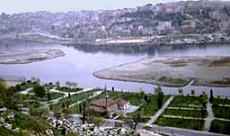
Latest News
New openings
The Zeyrek Cistern is opened to visits after years of restorations.
Entrance fees
As of 2026, Palace museums' entrance fees are raised.
Museum Pass
You can buy the "Museum Pass" for foreigners which is valid for 5 days in various museums of Istanbul.
Museums open 7 days
Many State museums in Istanbul operate 7 days a week, except Topkapi Palace.
The Golden Horn in Istanbul
 The Golden Horn, or Haliç in Turkish, is a horn-shaped fyord on the European side of Istanbul and is fed by two small streams. It is a natural harbor where Byzantine and Ottoman fleet and commercial ships were anchored. Today, it's surrounded by parks and promenades with ancient sites around it. Its name comes from the color of the water when at sunset it shines with a gold color because of the reflection of the sun.
The Golden Horn, or Haliç in Turkish, is a horn-shaped fyord on the European side of Istanbul and is fed by two small streams. It is a natural harbor where Byzantine and Ottoman fleet and commercial ships were anchored. Today, it's surrounded by parks and promenades with ancient sites around it. Its name comes from the color of the water when at sunset it shines with a gold color because of the reflection of the sun.
Golden Horn was an old trading harbor and a popular residential area during the Byzantine period. Its entrance was blocked by a huge chain to stop unwanted ships to enter. During the Ottoman period it was largely inhabited by Jewish immigrants from Spain. The mixtures of Armenians, Greeks, Gypsies and Turks living along its shores reflected the city's colorful ethnic mosaic.
In the beginning of 16th century Leonardo da Vinci projected a bridge to be built over the Golden Horn for the sultan. It was intended to be a single span of 240 meters (787 feet), 8 meters (26 feet) wide, and 24 meters (78 feet) high from the water, but it was never built.
In the first half of 18th century the Golden Horn was famous for its tulip gardens where upscale people came to enjoy and row with their boats at the romantic sunset. Many poets called it as "Sadabad" in their poems, or "place of bliss". Later on, Cibali cigarette factory was built in 1880 followed by other factories, which today houses a private university, and the Golden Horn was industrilized.
With the population explosion in the 1950's and ineffective building laws, the Golden Horn became an ugly storage of grey city-sewage and industrial waste with a terrible odor. But in the 1980's an urban clean-up began, clearing up these factories and building proper sewage systems around the Golden Horn. Now, its shores are green once again with parks, promenades, and playgrounds. There is still lots to do but at least now people don't have to change their course because of the bad odor, and they can even fish there.
Fener and Balat are old neighborhoods of the Golden Horn, with traditional old wooden houses, Byzantine churches, and a couple of old synagogues belonging to the first Jewish community who was settled here. The Orthodox Patriarchy resides here as well.
Eyup neighborhood towards the end of the Golden Horn is an important site for Muslims who are coming to visit and pray for the tomb of Eyub El Ensari, who was a companion of the Prophet Muhammad and died during the Arab siege of Constantinople in the 7th century. Around the mosque and the hills are covered with cemetaries from the Ottoman period. The Pierre Loti Cafe on top of the hill overlooking the shrine is a peaceful place to enjoy the view of the Golden Horn having a traditional Turkish coffee or tea.There was no bridge over the Golden Horn before the 19th century. Small boats provided transportation between the two shores. The first Galata Bridge, which connects present day Karaköy to Eminönü, was built in 1836, rebuilt in 1845, again in 1912, and lastly in 1993. The Unkapani (also named as Atatürk) Bridge further up the Golden Horn handles the flow of traffic between Beyoglu and Saraçhane. The third one over the Golden Horn is called the Haliç Bridge with the highway passing thru.
Hope to see you soon in Istanbul.

